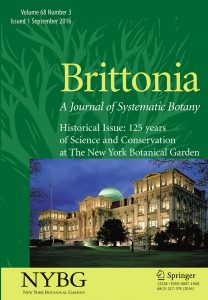125 Years of Science and Conservation at NYBG
Posted in Book on March 16, 2017 by Stevenson Swanson
Stevenson Swanson is the Science Media Manager for The New York Botanical Garden.
 By their nature, scientists tend to be forward-looking sorts. As they explore their field of research, one question leads to another question, which, inevitably, leads to yet another question. But a recent issue of Brittonia, a quarterly journal of botanical research published by NYBG Press, casts a backward glance at 125 years of science and conservation at The New York Botanical Garden.
By their nature, scientists tend to be forward-looking sorts. As they explore their field of research, one question leads to another question, which, inevitably, leads to yet another question. But a recent issue of Brittonia, a quarterly journal of botanical research published by NYBG Press, casts a backward glance at 125 years of science and conservation at The New York Botanical Garden.
Research has played a major role at The New York Botanical Garden since its founding—by a husband-wife team of plant scientists—in 1891. As Lawrence M. Kelly, Ph.D., the editor of this special issue, writes in an introductory essay, the Botanical Garden’s scientific programs are aimed at describing, documenting, understanding, and preserving plant diversity.
“The New York Botanical Garden is characterized by broad-ranging science programs, outstanding collections and facilities, a world-class staff, and a distinguished institutional history,” Dr. Kelly writes.
Essays by NYBG Science staff members survey the history and current state of the Garden’s programs in systematic and economic botany, floristic research, laboratory studies, and conservation activities, among other subjects. Articles also cover the collections and facilities that underpin the Garden’s research programs.
More recent developments are highlighted as well, including the ambitious projects to digitize the 7.8 million specimens in the William and Lynda Steere Herbarium and to update the Garden’s authoritative Manual of Vascular Plants of Northeastern United States and Adjacent Canada.
“These contributions provide evidence of the importance of NYBG’s work and how it has contributed to the ongoing evolution of plant science around the world,” he writes.
The special issue is available to Brittonia subscribers and via JSTOR, the digital library of academic journals.
To read or download an open-access essay from this special issue about the Garden’s historic and existing non-cultivated plant life, click here.
For information about how to subscribe to Brittonia, click here.

